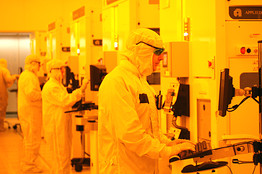Dec 4 2010
Mention the “Tech Valley” to someone and they could be forgiven for assuming that California’s Silicon Valley is the topic of conversation.
The Tech Valley is located in eastern New York and, though it’s not as well known as its sexier West Coast cousin, it is becoming a hot spot for tech companies.
 Working at CNSE
Working at CNSE
Today more than 200 high-tech businesses have a presence in the Tech Valley, a corridor that stretches from the Canadian border to just north of New York City. The region is home to the University of Albany’s College of Nanoscale Science and Engineering, the first (and only) educational institution dedicated solely to the research and development of nanotechnology. And, upon its completion in 2012, a new semiconductor plant being constructed by chip maker Globalfoundries – Fab 8 – will provide the area with 1,400 new jobs. Many of the new employees will be trained at CNSE, but other schools like Rensselaer Polytechnic Institute in Troy will also benefit.
Fab 8’s future employees owe their positions in large part to a state experiment. In 1998 New York began aggressively courting high-tech firms with generous financial incentives in the form of tax breaks and grants. The hope was that the semiconductor industry, one of the largest exporters in the United States, could reinvigorate the state’s economy.
High-tech behemoths IBM and GE have had factories in New York for decades, but in the mid 1990s they began downsizing. “Everyone felt that we had to be a player in tomorrow’s economy,” said Dennis Brobston, the President of Saratoga Economic Development Corporation, a nonprofit that works to market the region. “And that meant we had to be competitive in semiconductors.”
One of the cornerstones of the state’s strategy was the establishment of CNSE. While the state provided a crucial $900 million to develop the campus, the bulk of the capital - $6.5 billion - came from private companies with facilities on the site. CNSE students take classes on the same 800,000 square-foot campus where firms like IBM and Sematech do their research.
Current CNSE student Jenah Harris-Jones interns just a few minutes walk from her classrooms. A master’s of science candidate in nanoscale science, Ms. Harris-Jones’ internship is at Sematech where she is developing a $15 million electron microscope. After graduation she plans to continue working at the company full-time, an arrangement common for CNSE graduates.
Globalfoundries, a spinoff of Advanced Micro Devices, was also lured to New York by the state’s financial incentives. The company is building Fab 8 in Malta, N.Y., on an old NASA missile testing site. Construction on the new plant, which is expected to cost $4.5 billion, began in July 2009 thanks to $1.3 billion in state subsidies. Travis Bullard, the public affairs and communications manager at Globalfoundries, said that New York made the first move and came knocking in 2005. Less than a year later the state secured the deal, taking many in the industry by surprise.
“When we made the announcement in June 2006 we got a lot of questions about why we were building in New York,” Bullard said. “Up until that time it really wasn’t on the radar of the industry in any significant fashion. [But] now that people are more familiar with it I would say that slowly but surely New York is becoming the next cluster for the industry.”
In the wake of Fab 8’s construction, hundreds of ancillary companies have committed to coming to the area for Globalfoundries’ subcontracts. One of those is M&W Group, an engineering and construction management firm that expects to hire 600 workers mostly from the local market. “This is the first brand new site in the Northeast in almost 20 years,” said the M&W’s CEO and President Rick Whitney. “CNSE is the epicenter of nanotechnology research and development. Nowhere else could we be next to such a cluster of our core clients.”
Like some of her peers at CNSE, Ms. Harris-Jones is planning to stay in the Tech Valley indefinitely. Her 7-year-old daughter is enrolled at a local school and her husband quickly found a job soon after the couple moved from Iowa. “It’s clear to me that nanoscience is the future for many different types of technology,” she said. “Smaller faster cheaper is the mantra today.”
Source: http://www.sunycnse.com/Home.aspx